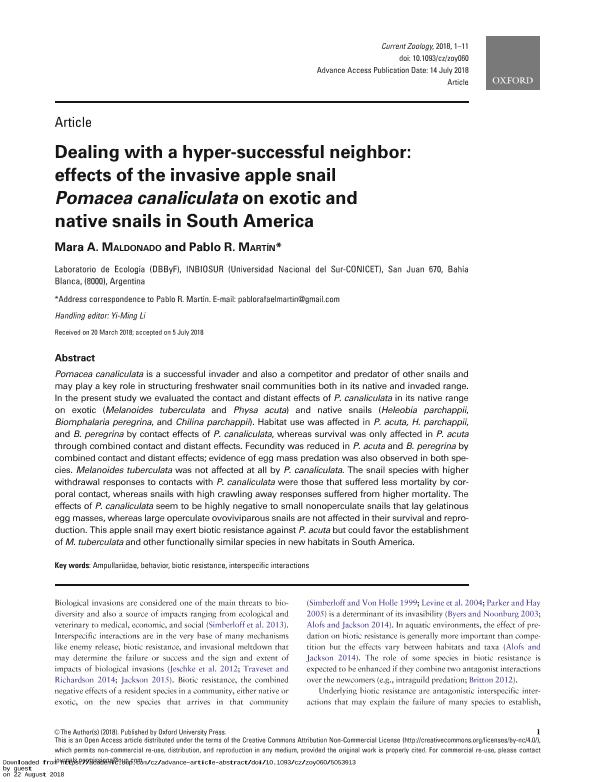Artículo
Dealing with a hyper-successful neighbour: effects of the invasive apple snail Pomacea canaliculata on exotic and native snails in South America
Fecha de publicación:
06/2019
Editorial:
Oxford University Press
Revista:
Current Zoology
ISSN:
1674-5507
e-ISSN:
2396-9814
Idioma:
Inglés
Tipo de recurso:
Artículo publicado
Clasificación temática:
Resumen
Pomacea canaliculata is a successful invader and also a competitor and predator of other snails and may play a key role in structuring freshwater snail communities both in its native and invaded range. In the present study we evaluated the contact and distant effects of P. canaliculata in its native range on exotic (Melanoides tuberculata and Physa acuta) and native snails (Heleobia parchappii, Biomphalaria peregrina and Chilina parchappii). Habitat use was affected in P. acuta, H. parchappii and B. peregrina by contact effects of P. canaliculata, whereas survival was only affected in P. acuta through combined contact and distant effects. Fecundity was reduced in P. acuta and B. peregrina by combined contact and distant effects; evidence of egg mass predation was also observed in both species. Melanoides tuberculata was not affected at all by P. canaliculata. The snail species with higher withdrawal responses to contacts with P. canaliculata were those that suffered less mortality by corporal contact, whereas snails with high crawling away responses suffered from higher mortality. The effects of P. canaliculata seem to be highly negative to small non-operculate snails that lay gelatinous egg masses, whereas large operculate ovoviviparous snails are not affected in their survival and reproduction. This apple snail may exert biotic resistance against P. acuta but could favor the establishment of M. tuberculata and other functionally similar species in new habitats in South America.
Palabras clave:
AMPULLARIIDAE
,
INTERSPECIFIC INTERACTIONS
,
BEHAVIOR
,
BIOTIC RESISTANCE
Archivos asociados
Licencia
Identificadores
Colecciones
Articulos(INBIOSUR)
Articulos de INSTITUTO DE CIENCIAS BIOLOGICAS Y BIOMEDICAS DEL SUR
Articulos de INSTITUTO DE CIENCIAS BIOLOGICAS Y BIOMEDICAS DEL SUR
Citación
Maldonado, Mara Anahí; Martín, Pablo Rafael; Dealing with a hyper-successful neighbour: effects of the invasive apple snail Pomacea canaliculata on exotic and native snails in South America; Oxford University Press; Current Zoology; 65; 6-2019; 225-235
Compartir
Altmétricas




